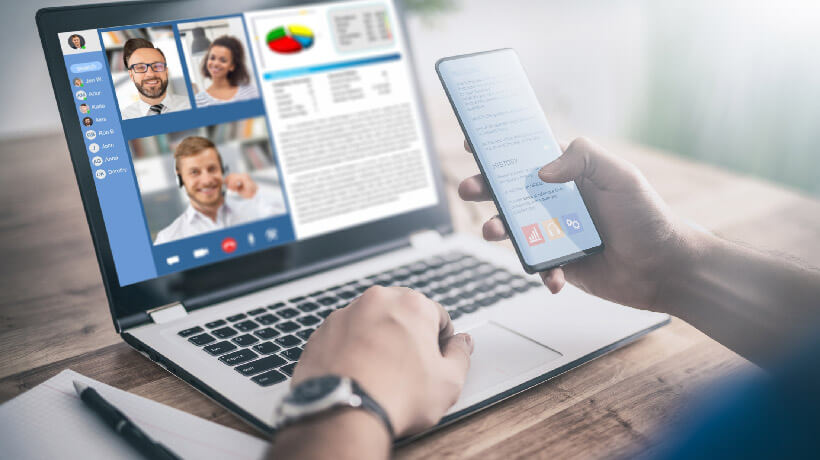What Is Mobile Learning?
Mobile learning (often referred to as “mLearning”) is a type of online learning delivered on mobile devices, like smartphones and tablets. Mobile learning stands out for its ability to fit into the learner’s lifestyle and offer on-demand learning anytime, anywhere. The content is usually downloadable and light, so employees don’t even need an internet connection to access their training.
Mobile courses support diverse delivery methods and content formats. Learners can attend ILT sessions for more detailed lessons or play simulation games for practice. At the same time, mobile learning surpasses traditional eLearning in terms of flexibility, ease of access, and engagement with training.
Learning on the go has a nemesis, though—distractions. So, to keep the learner’s attention undivided, mobile learning is often combined with a microlearning strategy. Game mechanics, like point-based rewards and leaderboards, are also deployed to motivate learners and help them track their progress.
Due to their convenience and high adoption rate, mobile devices are ideal for training all modern employees. Mobile learning is most useful, however, to companies with a deskless workforce. That is, employees like sales assistants, nurses, educators, truck drivers, and anyone who doesn’t work in an office or uses a laptop for their job.
Now that you know the basics of mobile learning, let’s see how mLearning contributes to better employee performance.
5 Ways Mobile Learning Can Improve Employee Performance
Mobile learning is convenient and engaging, but how does it work? Below we explain how mLearning helps employees perform better.
1. It Enables Learning On The Job
You can’t build “muscle memory” and master a skill unless you get your hands dirty and actually do something. This makes on-the-job learning the most effective way not only to learn but also to retain learning.
eLearning and on-site courses provide opportunities for practice through simulations or role-play. However, employees can’t access their instructor or their course right when they’re performing a task. Also, the effectiveness of practice sessions is limited compared to hands-on experience.
Mobile learning, on the other hand, is much closer to on-the-job training. Having access to training from their personal devices, employees can use their course as a guide and immediately apply the instructions given, especially when they’re trying to perform manual or other practical tasks.
2. It Offers Assistance At The Point Of Need
Employee performance has its ups and downs, sometimes due to external or unpredictable factors. An employee falls sick, for example, so someone else fills in temporarily for them. The replacement employee will need some time before they can do these new tasks, or tasks they haven’t done in a while, on their own.
Mobile course developers are smart people though. They know that an employee accessing training on the go needs to get an answer fast. That’s why mobile learning courses are easy to search and to consume, especially if they have been designed for mobile-first training. If, for whatever reason, an employee needs to refresh their memory while at work, a mobile learning repository can be their go-to tool.
3. It Gives Access To Training For Everyone
How can we even discuss improving employee performance when some employees don’t have access to training tools? All employees are entitled to development opportunities, but not everyone receives the same amount of training. Deskless workers, in particular, receive little or no training at all. As a result, their performance never really takes off or even plummets as time passes.
But each employee’s performance matters and contributes to your success. With mobile learning, all your employees—deskbound, deskless, or remote—can continue to upskill and reskill. Everyone works more efficiently because they have gained new skills or sharpened old ones. Also, don’t forget that employee engagement and employee performance are closely linked. Regular training revives your employees’ enthusiasm, which then motivates them to try harder and perform better.
4. Learners Engage More With The Course
When developing mobile learning courses, you have to factor in the challenges of consuming information on the go. Most notably, the abundance of distractions and shortage of time. The antidote to these barriers? Engaging content that employees can understand in the limited time they have available. In fact, mobile learning counts on engaging and comprehensible learning material in order to bring results.
Microlearning videos and activities ensure learners stay focused on their lesson, and gamification elements give them a reason to come back. Also, when their courses are in the palms of their hands, employees can make a habit of training regularly in short bursts. As they expand their knowledge base slowly and steadily, this knowledge is more likely to stick. To help them stay on track, set reminder notifications.
5. It Helps Employees Learn From Each Other
Sometimes formal training sticks to generic knowledge and doesn’t give concrete examples and tips that apply to the workplace. Luckily, where formal training falls short, social learning can fill in the gaps. In a discussion forum, for example, employees gain knowledge that comes from the experience of others. They get actionable and tried-and-tested tips and advice they can apply on the job.
Any course can provide a setting for group discussions. Although, employees are more likely to reach out to an instructor or fellow learners from their mobiles. That’s because everyone prefers to use their mobile phone to communicate. The communication over mobile is faster, more convenient, and less formal. Therefore, employees use social learning features more and benefit from the wisdom of experienced colleagues.
Conclusion
Corporate training has changed over the years to help employees learn faster and better. Mobile learning is part of this change, having emerged to appeal to modern employees and increase convenience for deskless workers. For a successful mobile learning strategy, choose your tools wisely. Look for an LMS that allows learners to download content so that they can view it offline. Also, make sure it offers a mobile app for those who access training mostly on their mobile devices.


